
HPU2. Nat. Sci. Tech. Vol 02, issue 01 (2023), 53-63
HPU2 Journal of Sciences:
Natural Sciences and Technology
journal homepage: https://sj.hpu2.edu.vn
Article type: Research article
Received date: 05-4-2023 ; Revised date: 24-4-2023 ; Accepted date: 25-4-2023
This is licensed under the CC BY-NC-ND 4.0
Privacy preserving using extended euclidean – algorithm
applied to RSA
Thi-Nhung Nguyen*
University of Information and Communication Technology, Thai Nguyen University, Thai Nguyen, Vietnam
Abstract
RSA cryptography is a strong encryption method widely used in online transactions. Using
the extended Euclidean algorithm is an important and efficient technique for finding the secret
key in RSA cryptography. This study provides an implementation of the extended Euclidean
algorithm to find secret keys based on RSA cryptography and hopes that it can be of help to
experts in the field of information security.
Keywords: Cryptography, Steganography, Watermarking, RSA, private key, Public key.
1. Introduction
Nowadays, with the explosion of information technology, transmitting and encrypting
information plays an important role in every human activity. It is a matter of life and death when
information can be attacked and stolen. For Industrial revolution 4.0, there is an increasing need for
information exchange between components in society. Furthermore, the need to connect with the
outside world is also higher. As a result, the computer network was created, bringing many benefits to
humans thanks to the quick and accurate exchange and process of information. Tasks can be solved
promptly and efficiently anywhere on Earth. However, these conveniences also raise a question: Is the
information sent from the sender to the recipient absolutely safe? Who can ensure that our information
is not accessed illegally and is kept confidential? In the communication system, information stored,
transmitted, and used on the public information network can be eavesdropped on, hijacked, distorted,
or destroyed, leading to incalculable losses. Especially, the data from the banking system, commercial
system, government management agencies or those in the military and diplomatic fields are exchanged
* Corresponding author, E-mail: ntnhung@ictu.edu.vn
https://doi.org/10.56764/hpu2.jos.2023.1.2.53-63

HPU2. Nat. Sci. Tech. 2023, 2(1), 53-63
https://sj.hpu2.edu.vn 54
in a secure and confidential manner. Therefore, data security is of paramount importance [2].
Cryptography plays an important role in providing security and ensuring safe data transmission over
the Internet. One of the principles of cryptographic techniques is to provide security for sensitive
information through digital signatures, authentication, verification, system security, etc. Thus,
encryption techniques ensure the security, integrity, and confidentiality of information and prevent
attacks and counterfeiting.
Along with the explosion of information technology, techniques for ensuring information security
in digital communications are divided into three different types: cryptography, steganography, and
watermarking. Each type of cryptographic technique has different applications and objectives, but all
aim to ensure the security of confidential information transmitted over insecure channels, such as the
Internet.
Cryptography and Steganography techniques are generally used to transmit sensitive information
between two or multiple entities within the same group or set. However, there are differences between
them.
Cryptography uses mathematical transformations to encrypt a message, turning each readable
message into a random sequence of characters, called ciphertext, to be transmitted over a public
network to an intended recipient. This is when two people, for example A and B, communicate with
each other, even though person C cannot read the content of the information, it is clear that A and B
are sending or exchanging information with each other without person C being able to grasp the
content. On the other hand, with Steganography, person C cannot know if there is any secret
communication or exchange of information between persons A and B [1]. To handle and ensure this
important matter, persons A and B will use an intermediary object, which is digital multimedia, such
as audio, video, or images…
Watermarking is similar in principle to Steganography but differs in its application purpose. The
objective of Watermarking is to embed information in an image in such a way that the Watermarking
cannot be shifted and does not destroy the integrity of the original image carrying the message, i.e.,
preserving the original content of the message during transmission. Watermarking is often applied in
areas such as copyright protection.
The next part of the article will focus on cryptographic systems and their development, as well as
the mathematical foundations.
2. Theoretical basis
2.1. Cryptosystem
Mathematically, a cryptosystem or encryption scheme can be defined as a tuple (P, C, K, E,
D) with the following properties.
1. P is a set called the "plaintext space". Its elements are called plaintexts.
2. C is a set called the "ciphertext space". Its elements are called ciphertexts.
3. K is a set called the "key space". Its elements are called keys.
4.
,
k
E e k K
is a set of functions
:
k
e P C→
. Its elements are called "encryption
functions".
5.
,
k
D d k K
is a set of functions
:
k
d C P→
. Its elements are called "decryption
functions".

HPU2. Nat. Sci. Tech. 2023, 2(1), 53-63
https://sj.hpu2.edu.vn 55
For each
eK
, there is
xK
such that
( )
( )
,.
xk
d e x x x P=
for all .[12]
Cryptographic features. Provides a high level of security, integrity, non-repudiation, and
authentication.
Confidentiality: Secure message content and data by means of encryption techniques.
Integrity: Assures the parties that the message has not been altered in transit.
Non-repudiation: Can confirm that the document has come from someone, even if they try to
deny it.
Authenticity: Provides two services: identifying the origin of a message, ensuring that it is
genuine. Check the identity of the person who is logging into the system, further checking their
identity in case someone tries to connect and pretends to be a legitimate user.
2.2. RSA encryption
Symmetric encryption, for example AES, uses the same key for both encryption and decryption.
The advantage of this method is fast processing speed, small size of encrypted data. However, the
security is not really safe when it is necessary to exchange information at the processing level with
many parties receiving and sending data. Asymmetric encryption, also known as Public Key
Cryptography, is a method performed on two keys. One key is used for encryption (public key) and
one key is used for decryption (private key). The private key is used to decrypt and is kept secret, the
public key is the key used to generate the encryption and is made public so that anyone can use it to
send messages to the subject. The decryption key cannot be calculated from the encryption key. The
advantage of public encryption is that key management is more flexible and efficient. The user only
needs to protect his private key. However, the disadvantage of public encryption lies in the execution
speed, which is much slower than symmetric encryption.
RSA is a public key cryptographic algorithm, first described by Ron Rivest, Adi Shamir and Len
Adleman in 1977 at the Massachusetts Institute of Technology (MIT). The name of the algorithm is
derived from the first 3 letters of the names of the three authors [3]. The RSA algorithm was patented
by MIT in the United States in 1983 (Registration No.4.405.829).
RSA is widely used in encryption and digital signature technology. In this encryption system, the
public key will be shared publicly for everyone. The RSA operation is divided into 3 steps: key
generation, encryption, and decryption.
Operation Description:
Public key: Open to the public and encrypted.
Private key: Publicly encrypted information can only be decrypted with the corresponding private
key.
Key Generation process in RSA:
(1) Select two large prime numbers
,pq
with
.pq
(2) Derive the value of n as
*n p q=
.
(3) Calculate the totient value as
( ) ( )( )
11n p q
= − −
.
(4) Choose a natural number
( )
1en
and is a co-prime with
( )
.n
(5) Calculate d such that d is congruent with e, i.e
( )
( )
1 mod .de n
=

HPU2. Nat. Sci. Tech. 2023, 2(1), 53-63
https://sj.hpu2.edu.vn 56
(6) Pair
,ne
is the public key, pair
,nd
is the private key.
Encoding/Encryption process: The sender converts the plaintext M into a number m, m < n,
according to a pre-agreed reversible function (from m can redefine M). Calculate c as the ciphertext of
m by the formula:
mod ).(
e
c m n=
Send c to the recipient.
Decoding/Decryption process: The receiver receives c and knows n (publicly) so it can find m
from c according to the following formula:
( mod ),
d
m c n=
where d is the inverse of e modulo
( )
.n
This inverse exists under the condition
( )
( )
, 1.en
=
The security of the RSA system is based on two mathematical problems: the problem of prime
factorization of large integers and the problem of RSA. If the above two problems are difficult, then it
is not possible to perform complete decryption for RSA. The RSA problem is the problem of
calculating the square root of e modulo n (where n is composite): find the number m such that
mod ,me c n
=
where
( )
,en
is the public key and
c
is the ciphertext. Currently, the most promising
method to solve this problem is to factor n into prime factors. When doing this, the attacker will find
the secret exponent
d
from the public key and can decrypt it according to the algorithm's process. If
an attacker finds two primes
p
and
q
such that:
.n p q=
, it is easy to find the value
( )( )
11pq−−
and
thereby determine
d
from
.e
As of 2005, the largest number that can be factored to a prime is 663 bits with the distributed
method while the RSA key has a length of 1024 to 2048 bits. Some experts believe that a 1024-bit key
may soon be broken (there are also many who oppose this). With a 4096-bit key it is unlikely to be
broken in the near future [1]. Therefore, it is generally assumed that RSA is secure provided that n is
chosen large enough. If it is 256 bits or shorter, it can be analyzed in a few hours with a personal
computer using available software. If n were 512 bits long, it could have been parsed by several
hundred computers by 1999. A theoretical device called the TWIRL described by Shamir and Tromer
in 2003 raised questions about security. the whole of a 1024-bit key. Therefore, it is currently
recommended to use keys with a minimum length of 2048 bits.
To overcome this problem, the Extended Euclidean Algorithm (EEA) plays a very important role
to generate the secret key d. Therefore, privacy is preserved. The next part of the paper presents the
basic mathematical knowledge used in RSA cryptography.
2.3. Euclidean Algorithm, Extended Euclidean Algorithm
The Euclidean algorithm is a simple algorithm for calculating the greatest common divisor (GCD)
of two positive integers. This algorithm is named after the Greek mathematician Euclidean in his book
"Fundamentals of Geometry" (Elements).
The Euclidean algorithm works by repeatedly dividing the larger number by the smaller number,
until the smaller number is zero. The application of the Euclidean algorithm is very wide in
mathematics and computer science. In the RSA cryptosystem, the Euclidean algorithm is used to find
a number that is relatively prime with a certain positive integer. Specifically, the process of generating
public and private keys of the RSA cryptosystem is as follows:
Step 1: Choose two primes p and q with large differences, calculate n = p*q.

HPU2. Nat. Sci. Tech. 2023, 2(1), 53-63
https://sj.hpu2.edu.vn 57
Step 2: Calculate co-prime with (p-1)*(q-1), is called the number e. We use Euclidean algorithm
to find the number e, such that GCD(e, (p-1)*(q-1)) = 1.
Step 3: Calculate the number d such that (d*e) % ((p-1)*(q-1)) = 1. We can use the Euclidean
expansion algorithm to find this number d.
Step 4: The public key is the pair (n, e), the private key is the number d.
When there is a message that needs to be encrypted, the sender uses the public key (n, e) to
encrypt the message. The receiver will use the secret key d to decrypt the message. When the receiver
wants to reply back to the message, they will use the public key (n, e) to encrypt the message and send
it back to the sender [9].
We denote as the set of integers,
..., 2, 1,0,1, 2,...= − −
and
+
is the set of non-negative
integers,
0,1,2,... .
+=
The set is closed to addition, subtraction, and multiplication, but not to division: dividing an
integer by an integer does not always result in an integer. Therefore, the case of divisibility, i.e. when
the integer a is divided by the integer b, the quotient is an integer
, . ,q a b q=
has a special meaning.
Then we say that
a
is divisible by
,bb
is divisible by
,aa
is a multiple of
,bb
is a divisor of
,a
and
denoted by
.ba
It is easy to see right away that 1 is a divisor of all irregular integers, zero is a
multiple of any integer, every integer
a
is a divisor, and at the same time a multiple, of itself.
Let
( )
,1a b b
any two integers. By dividing
a
by
b
, we get two numbers
q
and
r
such that
. , 0 .a b q r r b= +
The number
q
is called the quotient of the division of
a
by
,b
denoted
divab
and the number
r
is called the remainder of the division
a
by
,b
the symbol
mod .ab
Example:
30 div 7 4=
and
30 mod 7 2, 30 div 7 5= − = −
and
30 mod 7 5.
An integer d is said to be a common divisor of two integers a and b if
da
and
.db
An integer d
is said to be the greatest common divisor of a and b if
0,
dd
it is a common divisor of a and b, and
all common divisors of a and b are less than or equal to
.d
Denote the greatest common divisor of a
and b as
( )
gcd a,b .
Example:
( ) ( )
gcd 12,18 =6, gcd -18,27 =9.
It is easy to see that for every positive integer a we have
( )
gcd a,0 =a,
we will also convention that
gcd(0, 0) = 0.
Theorem1: If b ≠ 0 and
b a
, then we have
( )
,.gcd a b b=
If
.,a b q r=+
then gcd(a, b) = gcd(b, r).
An integer m is said to be a common multiple of a and b if
am
và
.bm
The number m is called
the least common multiple of a and b, and is denoted by
( )
lcm a,b ,
if m is a common multiple of a
and b, and every common multiple of a and b is greater than or equal to m.
Example:
lcm 15, 20( ) = 60.
any two positive integers a and b, we have the relation
( ) ( )
lcm a,b .gcd a,b =a.b.

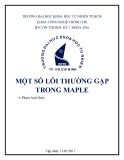



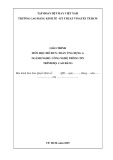
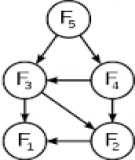


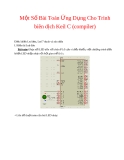











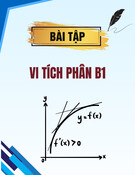



![Quyển ghi Xác suất và Thống kê [chuẩn nhất]](https://cdn.tailieu.vn/images/document/thumbnail/2025/20251030/anh26012006/135x160/68811762164229.jpg)
